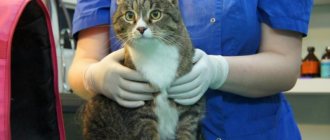12210Administration
We all love animals, but cats are not the least important on the list of pets. Yes, such cohabitation has many charms, but sometimes the owners of furry cohabitants have to face the need for sterilization, since their pet actively walks.
This can be explained, first of all, by the reluctance to get offspring and certain inconveniences associated with it. Having decided to perform an operation on their pet, every second owner asks a completely logical question: can a sterilized cat go on a spree?
Can a cat go for a walk?
Unfortunately, binge drinking after sterilization cannot always be avoided. Cases when a female walks after sterilization are rare, but they do occur. A cat asks for a cat after surgery only as a result of the following factors:
- Poor quality sterilization;
- Hormonal duplication;
- Ectopic ovarian tissue syndrome.
The manifestation of signs of heat and the appearance of estrus is mainly characteristic of females that have been operated on already in adulthood. She walks because the animal’s hormonal background changes significantly after the operation.
Why does a cat ask for a cat after sterilization?
The instinctive behavior of cats during estrus is due to the influence of hormones, so it is not always possible to expect it to stop after sterilization. There are different types of surgeries in which only part of the reproductive system (uterus or ovaries) is removed. When tubal ligation occurs, all organs retain their functions.
Before sterilization, it is necessary to determine whether the owner wants to rid the domestic cat of sexual desire or just wants to prevent the appearance of unnecessary offspring if the pets walk on their own.
The following types of sterilization are carried out in veterinary clinics:
- Removal of only the ovaries or all reproductive organs at once. During an oophorectomy or ovariohysterectomy, the veterinarian removes the ovaries, which produce some of the hormones that cause the cat to show signs of heat.
- Hysterectomy. Only the uterus is removed, the ovaries remain. The cat is unable to become pregnant, but the ovarian hormones continue to be produced.
- Tubal occlusion. When the fallopian tubes are ligated or cut, both the uterus and ovaries remain in their physiological places. The cat loses the ability to produce offspring, but its hormonal levels continue to change in accordance with the natural cycle.
To avoid hormonal surges and sexual heat in domestic cats, you need to choose surgery that involves removing the ovaries. With all other types of intervention, this organ will continue to produce hormones and ensure the animal’s sexual behavior.
How to avoid the noise of a sterilized cat?
Even if a sterilized cat is walking again, it is necessary to immediately take certain measures so that a stable cycle does not establish. An effective measure is the introduction of hormonal drugs . In very rare cases, this procedure requires repeating. Note that if sterilization took place a few days ago or has reached a period of 7 months, and the sterilized female is still walking, an injection of a hormonal drug will definitely help. If sterilization was done a year ago, or even more, the pet is walking for a completely different reason.
Pet aggression
Cat after sterilization: care at home
After recovering from anesthesia after surgery, the animal experiences stress and pain, which will cease to manifest itself only after a few days. The main sign of postoperative discomfort is the manifestation of aggression. The animal scratches, bites, growls and hisses. It reacts sharply to any noise and behavior of others. Even attacks on people are possible. In this case, you need to consult a veterinarian on what to do. Most likely, the animal will need to organize a separate room where no one will disturb it for several days.
Poorly performed sterilization: consequences
One of the most obvious explanations for the fact that a sterilized cat began to walk again is that the animal was not properly sterilized. The pet is walking with this turn of events, since veterinarians might not have removed a piece of the ovary or even the whole ovary at all during sterilization. Then, in the first month after sterilization, she resumes hunting again and then walks the same way as before the operation. This case is quite rare and, if detected, requires immediate extensive abdominal surgery. Laparoscopy is not used in this case, since its results are ineffective for a pet that has already been sterilized once.
Should a cat stop marking?
The female stops marking after sterilization if she has not yet reached sexual maturity at the time of the operation.
Otherwise, such sexual behavior has already been established, and the lack of hormones may not affect it. In addition, this behavior completely depends on the character of the cat. She may not like such a small thing as the location of the tray, unknown and unpleasant odors, or simply the surrounding environment, but she can express her dissatisfaction in one of the few ways - by leaving marks.
The owner can deal with this problem in several ways.
- Ensure good ventilation in the house, eliminating unpleasant odors.
- Make sure the cat is not bothered by anything. In case of anxiety, you can rub flower infusions into the inside of the ear. They can also be added to the water that the animal drinks - no more than 1-2 drops.
- Special preparations sold in pet stores can eliminate the odors of existing marks. Their use is quite lengthy: most often, the areas marked by the cat must be treated every day for a month.
Reference!
Of course, all of the above should be put into effect only after the owner is convinced that sexual behavior has been consolidated and the operation has been performed correctly. If the production of hormones in the cat's body continues, the above methods may not help.
A cat walks after sterilization: hormones and their effect on the body
Certain hormones are responsible for puberty and the occurrence of estrus in females. They are produced by the following organs:
- Ovaries;
- Pituitary gland;
- Hypothalamus;
- Adrenal glands.
Here it is important to know and understand that as a result of hormonal imbalance, the hormones of the pituitary gland and hypothalamus are capable of forming a special hormonal background, similar to that of an animal that is walking. This outcome is quite likely for both sterilized and unsterilized individuals.
The adrenal glands, in turn, when tumor tumors occur in them, are also capable of changing the hormonal levels in sterilized cats.
The essence of the procedure: what is it?
It is best to do castration at the age of 6 months.
There are two ways to deprive an animal of its ability to bear children:
- sterilization (vasectomy);
- castration (ovariohysterectomy).
Surgery to sterilize a cat involves ligating the ovaries or removing the uterus. Thus, the production of hormones, for which the ovaries are responsible, does not stop. This method is chosen by pet owners who want to preserve the instincts of their pet. But a more humane way to carry out castration is a surgical intervention in which the reproductive organs are completely removed. Then the adrenal glands are responsible for hormonal production, and the cat does not require mating.
What other cases are there?
In veterinary practice, there are a number of specific cases when the sex hormonal background of a sterilized individual was determined by diseases occurring in the thyroid gland. Aligning and adjusting the balance of hormones in this situation is not an easy task, which may include a number of stages:
- Exclusion of hormone-producing tumors;
- Chemical suppression of sex hormones.
Most often, the latter is performed by implanting a special capsule under the skin.
Consequences of sterilization
If the first operation was performed on the furry purr, then it is clear why the sterilized cat screams. The instincts remain the same. In general, the sterilization procedure is regarded by many veterinarians as abuse of animals. After all, with such an operation, the owner dooms the pet to lifelong torment. The sexual instinct will manifest itself every time, but the maternal instinct will never be satisfied . This will only cause the animal to suffer. In this case, the pet will experience hormonal explosions throughout its life, and concerts at home are inevitable.
© shutterstock
Drawing conclusions
To summarize whether sterilized cats walk after surgery, I would like to repeat this. Sterilization implies the loss of exclusively reproductive function, that is, estrus, and the desire to mate in a sterilized female may remain.
I have a cat 1-1.5 years old, sterilized, we live in a large private house, our own yard, she went out and visited the neighbors in winter, and then she left for 3 days and is not there, I go every day looking for her, I look for her in white I announced that I threw a fang (but the result is zero, I’m sitting and crying, will he come back or not, there are private houses and 9-story buildings around, maybe someone took it... what the hell should I do?(
that year my cosmos also escaped through the window of the apartment, I was 3.5 weeks old and everyone told him he was screwed, he was hit by a car or eaten, and every day I was rummaging through the basements and posting advertisements and on social media. I wrote on the networks, then I found it near the trash can, like a dirty and fat pig, I couldn’t wash it for 2 days) and now here it is again (I so want my Busya to come back ((((((((
The problem of a wandering cat worries not only its owners living in a high-rise apartment, but also those around them. The pet meows heart-rendingly, inviting the cat.
An uncontrollable instinct forces an adult female to engage in procreation. The owner decides to sterilize the pet. But time passes and the cat, deprived of the opportunity to reproduce, returns to its old ways. Why is this happening? What to do?
What measures to take?
What to do in such a situation? And should you pay attention to your pet’s behavior? The answer is clear - it is necessary. If you let the situation take its course, then the sterilized pet’s cycle may be restored and such behavior will be regular. If the problem is not the quality of the operation, then veterinarians recommend medical intervention - it is necessary to inject the cat with a hormonal vaccine, such as Covinan or depot-gestone. This may need to be done twice. In any case, it is advisable to do this only after the recommendation of a veterinarian.
A sterilized cat asks for a cat: 4 reasons
There are the following causes of estrus in sterilized females:
- Incomplete removal of epididymal tissue. Occurs when an unremoved piece of ovarian or epididymal tissue remains, which is capable of regenerating and partially replacing the internal secretion organ. Estrus occurs as usual, but pregnancy does not occur and the pet will not be able to bring kittens. Repeated surgery, as a rule, does not solve the problem. Not every veterinarian is able to find the criminal piece of tissue, and repeated anesthesia will harm the cat’s health. However, the chance of achieving a positive result increases if the uterus and surrounding tissue are removed.
- Development of the reminant ovary. After the removal of the reproductive organs, the pituitary gland or adrenal glands begin to produce sex hormones. Statistics show that one out of seven castrated cats can retain the ability to secrete estrogen.
- Congenital anomaly. Cells of the ovarian appendages take root in other organs.
- Development of a hormone-like tumor. The neoplasm has the ability to secrete estrogens. Pathology is observed in cats that were castrated in adulthood.
What should the owner do?
If symptoms characteristic of a period of estrus appear, you should immediately take your cat to a veterinarian. To accurately establish the cause of behavior atypical for a castrated animal, an ultrasound examination is performed to identify the part of the ovary remaining in the body. An additional blood test is also done to study hormonal levels. However, diagnostics cannot always reveal the root cause why a sterilized cat is drawn to go for walks.
In case of hormonal imbalance, the animal is recommended to take injectable forms of appropriate medications.
If the ultrasound shows the presence of an ovary or part of it, then a broadband operation is performed. Minimally invasive intervention is ineffective in this case. In case of hormonal disorders, medications are prescribed that will suppress the animal’s sexual desire. Medicinal substances are injected with a syringe into the scruff or muscle exclusively by a veterinarian after an examination.
If estrus in a sterilized pet is caused by an imbalance of hormones, treatment must be carried out in the first months, until the body is rebuilt. Violations manifest themselves within 1-6 months. from the moment of sterilization.
When estrus is caused by thyroid disease, the cat is examined for the presence of malignant neoplasms. Hormones that cause sexual desire are suppressed by implanting capsules under the skin. A neutered cat returns to a normal lifestyle after one session; repeated treatment is rarely required. It is strictly prohibited to self-medicate or make injections yourself if the endocrine glands malfunction.
What to do if the cat continues to walk after sterilization?
The owner has the following options for dealing with the pet’s wandering behavior despite the surgery:
- You need to be patient and wait until the concentration of hormones that were produced before sterilization drops.
- Carry out a repeat operation. In most cases, it is financed by the surgeon who performed the first one. However, it should be noted that all anesthesia drugs have side effects.
- If estrus occurs, use medications to regulate sexual heat, which will be prescribed by a veterinarian.
Why does a cat scream: main reasons
Using ultrasound, you can identify the remaining ovary in an animal.
If a sterilized cat screams at night, it means that she has preserved her sexual instincts. An animal that continues to produce hormones requires a partner. When mating does not occur, the maternal instinct is not satisfied, and therefore the cat experiences severe stress. Therefore, many doctors consider such an operation inhumane. But if a pet screams after castration, this may indicate an incorrect procedure: the doctor could remove only one ovary from the cat, which is why hormonal secretion will persist. This can be checked using ultrasound. And also if the pet calms down after taking hormonal drops, this indicates that the procedure was done unsatisfactorily.
If the surgery was performed correctly, but the cat still yells, this may be a sign of adrenal disease. In addition, if the operation was performed during estrus, then for some time the cats still cry instinctively. Then you need to wait a few more days for the cat’s hormonal levels to settle. A pet sometimes meows after sterilization if the procedure was performed late, after the age of 5 years. Then the cat only repeats its previous behavior and imitates sexual heat. But sometimes it happens that a cat simply shows his character, and does not scream because of troubling health problems.
What does a veterinarian do?
Alas, not all reasons when a cat is in heat after sterilization can be corrected and eliminated.
- First of all, inertial estrus is excluded - estrus that occurs against the background of remaining sex hormones in the blood.
- An ultrasound is done to check if all the ovaries were removed correctly. It is carried out quite rarely - you need a very good ultrasound machine, with which you can identify the ovaries of a cat. Normally they are very, very small in size. An ectopic and reminiscent ovary cannot be seen by ultrasound.
- Taking tests to determine the presence of tumors in the body.
- A blood test is performed to determine the levels of the main sex hormones - progesterone and estradiol - without stimulation.
- Various tests are performed to stimulate sex hormones and take blood before and after. Comparison of results and assessment of the situation. Usually, with the help of such studies, it is possible to determine whether the glandular tissue that produces sex hormones remains in the body or not. But, alas, it is impossible to determine where exactly the ectopia is located! This also includes checking the level of luteinizing hormone, as well as stimulating tests with gonadotropin-releasing hormone and gonadotropin.
- Carrying out an AMH (Anti-Mullerian hormone) test, which can be used to determine whether the sex glands produce hormones or whether hormonal duplication occurs in other organs (adrenal glands or pituitary gland). This hormone is produced only by the tissues of the testes in cats and the ovaries in cats. If it has been determined, it means that we are talking about ectopia or the remains of poorly removed genital organs.
- Carrying out a repeat operation to excise the remaining or incorrectly removed ovaries.
- Carrying out surgery to remove glandular ectopia. It is carried out very rarely, because these tissues can be located absolutely anywhere in the body and it is impossible to know for sure where to look for it.
- Performing surgery to remove hormone-producing tumors.
- Carrying out medicinal correction of the functioning of those organs and systems that are involved in hormonal duplication.
- Prescribing hormone replacement therapy to normalize general hormonal levels when repeated operations are not possible. Attention: absolutely all hormonal drugs have a sufficient number of side effects, so self-medication is highly discouraged!
The actions are presented in the order in which manipulations are usually carried out. Unfortunately, it is impossible to say in advance how many and what kind of studies will be needed in each specific case.
At what age is sterilization performed?
If we talk about sterilization, then you need to know that the opinions of experts here differ.
According to some veterinarians, a cat can be sterilized even at two months , without waiting for it to start asking for sexual intercourse. This is due to the fact that nothing is removed from the organs. And this does not affect the growth and development of the animal.
According to other experts, such early sterilization can disrupt the development and growth of internal organs. Which seems to lead to disability. Accordingly, it is better to wait for sexual heat and the moment when the cat begins to ask for a cat.
For greater safety, it is better to sterilize from 7 months of age. Adult animals can also undergo this procedure. The main requirement is an exceptionally healthy cat.
© shutterstock











